#CivicTech GCDigital DigitalGov CodeForCanada
Explore tagged Tumblr posts
Text
Policy and Rules as Code
Policy is central to what governments do. It allows us to align on intention and make decisions based on principles and procedures.
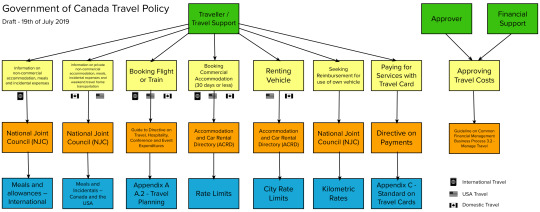
When researching travel policy, I found an overwhelming amount of information. There was so much information between policies, directives, standards and guidelines I found it difficult to know where to start.
Rules as Code
At this point, I was already thinking "Wow, wouldn't it be great if we could centralize all of this information and make it available as an API?"
As it turns out, there's a global movement already heading in this direction. In Ottawa, Scott McNaughton is leading an initiative to offer pilots as proof of concept on Rules as Code. Our friends at Code for Australia are also working on a project with the New South Wales government. The French Government are also implementing rules of code with OpenFisca.
What is Rules as Code?
Rules as Code is converting "prescriptive conditions found in legislation and policy" into logical rules. This means that decisions can be made in an 'if this, then that' fashion.
Instead of a human having to read and interpret rules, a computer will be able to determine if a policy requirement is met by considering parameters and responding with a true/false answer, at which time the system can act on that information.
Centralise & Standardise - One Source of Truth
Many current systems are designed to incorporate rules and can be configured to make decision based on policy. Rules as Code takes this one step further. We can centralise and standardise the format of policy via an API (application programming interface) and create 'one source of truth', meaning that any system that is integrated can be current, without requiring system-level updates.
What it Means for Travel
Processes involved in requesting, approving, and booking travel are entwined with policy, requiring users to reference and research.
Rules as Code introduces the possibility of querying policy as part of a system's workflow, automating policy decisions and taking the cognitive load off the user.
Adoption
Is Rules as Code an interpretation of existing policy or does it require drafting policy alongside French and English?
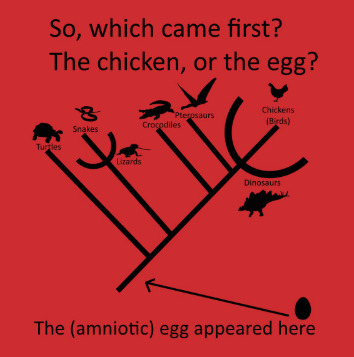
Expressing policy as code gives us the ability to think in an intermediate language, which is inherently based on decision making. By thinking in logical terms first, it forces us to consider an outcome. Natural language explaining it may become more concise and definitive.
The conversion of policies developed over hundreds of years is a mammoth task. The technical side of Rules as Code is relatively simple, but pushing through the bureaucracy surrounding policy and equipping policy makers with skills to think in code is an ambitious undertaking.
Thinking Big
Rules as Code has huge potential. If it reached the point of being a standard in government it would have a huge impact on how policy is used and perceived.
What do you think of Rules as Code? Is it the next big thing for policy?
-Mike, Software Development Fellow - Code for Canada
6 notes
·
View notes
Text
Celebrating wins: reflecting on the weeks of November 18-22
This week, our team is celebrating a few huge wins!
We finally presented a (beta version) of our insights report to our core team this week.
It’s currently a monster 155 page document since we had so much rich data from our deep discovery phase! Now that our analysis is complete and fully documented, we can draw from it to present to various audiences and - most importantly - use it as the basis for building out prototypes of our product!
Here’s a sneak peek at some slides, demonstrating the breadth of what’s covered in this report: a journey map that more accurately demonstrates the ways that applicants to MSP engage in the various touchpoints throughout the process; exploring the purpose behind certain steps and demonstrating where understandings are shared or divergent; and explaining how code can be used to streamline the process to be more opinionated in the way we collect data.
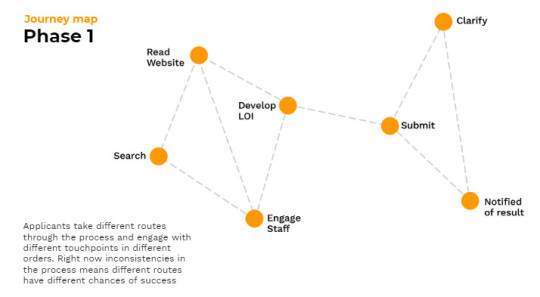
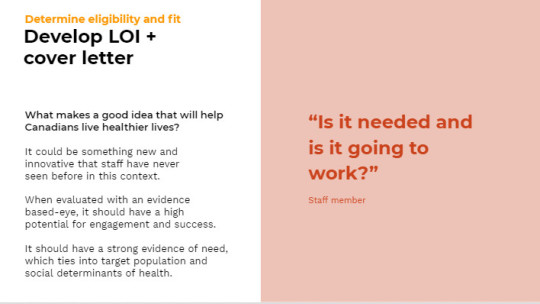
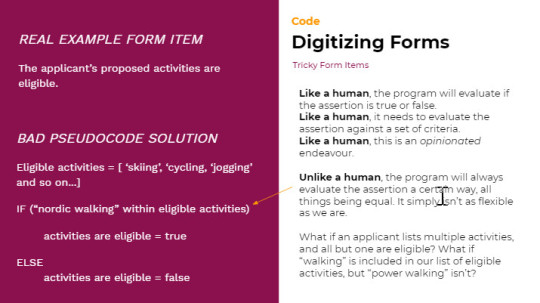
We’ll do a deeper dive into our research in another blog post soon, but for now, just know we’re pretty amped about it!
Another long-time-in-the-making milestone this week was finally getting set up for a trial instance with Apply by SurveyMonkey.
This is the Software as a Service (SaaS) solution that we’ve been leaning towards, and now we finally have an opportunity to play around with it - ie. the design, build, test part of our fellowship! We are so excited to be able to show staff more tangibly how digitization of the MSP program can improve the applicant experience, while making their own lives easier, too.
So far, Adam’s been exploring how to create different projects within it...with some existential dummy data (very On Brand for him).
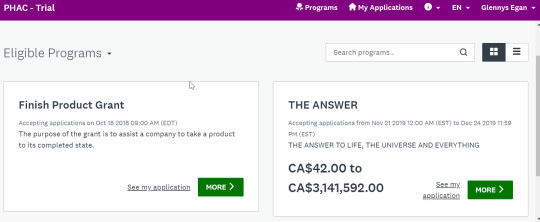
The final big milestone we hit this week was the official receipt of the Options and Analysis that had been initiated some months back by Health Canada Corporate Services in order to determine which back-end system we’d be integrating with. As you’ll know if you’ve been following our project, we are now pushing for an end-to-end solution - Apply - but it took us some time to convince Corporate Services that this was the right direction. The Options and Analysis documentation is the first step in having them support us to go in this direction and perhaps socialize SaaS solutions more broadly throughout Health Canada, when appropriate. Fingers crossed!
And, on that note, we are going to finish our big week off right by heading out for a drink together. Team building and celebrating successes are important, ya know?!
Glennys, Product Manager
#civic tech#civictech#digital government#digitalgov#product design#uxresearch#code4canada#code4all#codeforcanada#gcdigital
1 note
·
View note
Text
Drowning in Data (but in a good way!)
Hello! You haven’t heard from us in a while because we’ve been focused on publishing our first official Code for Canada blog, were at our first Code for Canada Fellow retreat, and have been absolutely drowning in data. But these are all good things!

Code for Canada Fellows goofing around at our first retreat.
We wanted to give a quick check-in on where we are with our discovery research and data analysis, so you know why we’ve been quiet.
During the UX research phase, we completed:
More than 30 hours of interviews, including with past, current and potential applicants, staff, and stakeholders
Two design probes breaking down the Letter of Intent template
Analysis of the contents of the PSD inbox, which is often the first point of contact for applicants interested in the program
Observational studies of PHAC processes and ways of interacting with applicants
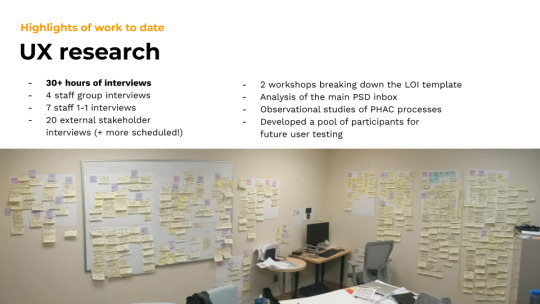
Slide from our most recent Project Panel presentation, where we gave an update about our work, including our UX research process.
As you can see from the walls in our office (and even the filing cabinet), where more than 500 are posted, this has given us at least a thousand data points! We’ve been working hard on collating, synthesizing, and analyzing that data. My dog, Boris, helped.
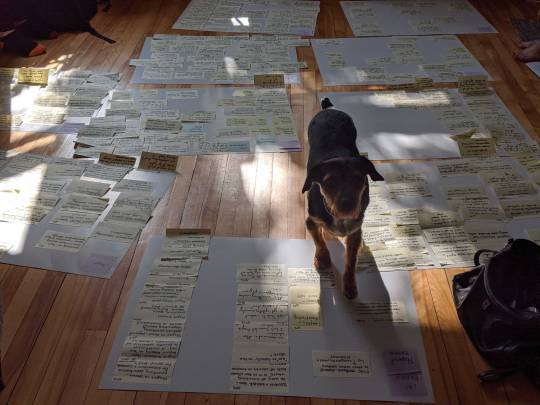
My sweet dorkie (no, actually, that’s his breed) dog dorking out with us during data synthesis.
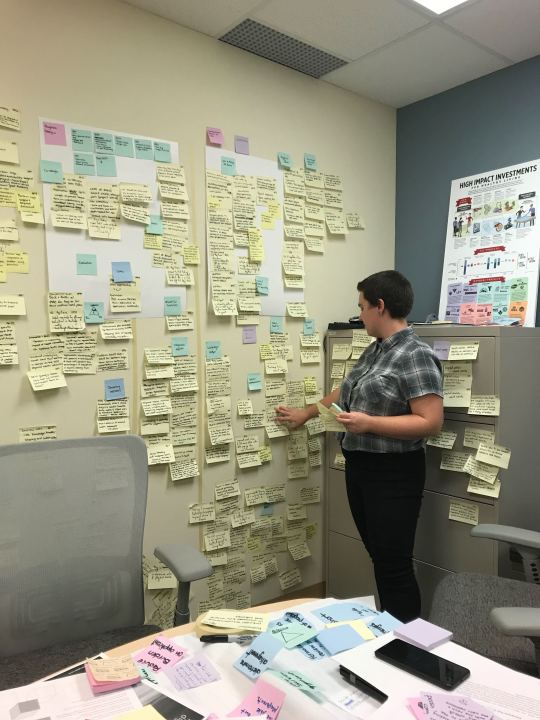
Rose working on analyzing our data points, which have spilled over from the walls to the tables and filing cabinets. Oof.
In the next week or two, we’ll be delivering an insights report that identifies key areas of opportunity to streamline the MSP program’s application process for users, as well as make it more accessible to the types of innovative organizations across the country that it intends to serve.
- Glennys, Product Manager
#civictech#digital government#gcdigital#digitalgov#Digital Transformation#codeforcanada#CodeForAll#code4all#code4canada
1 note
·
View note